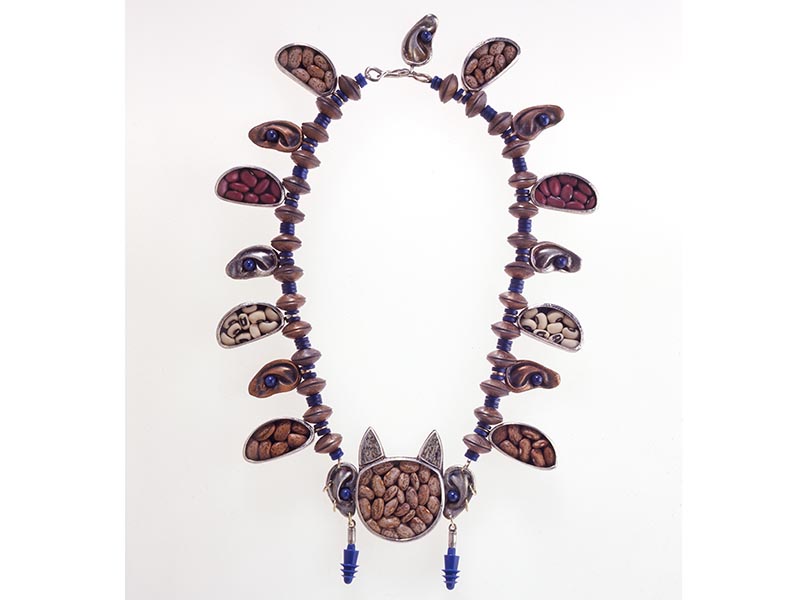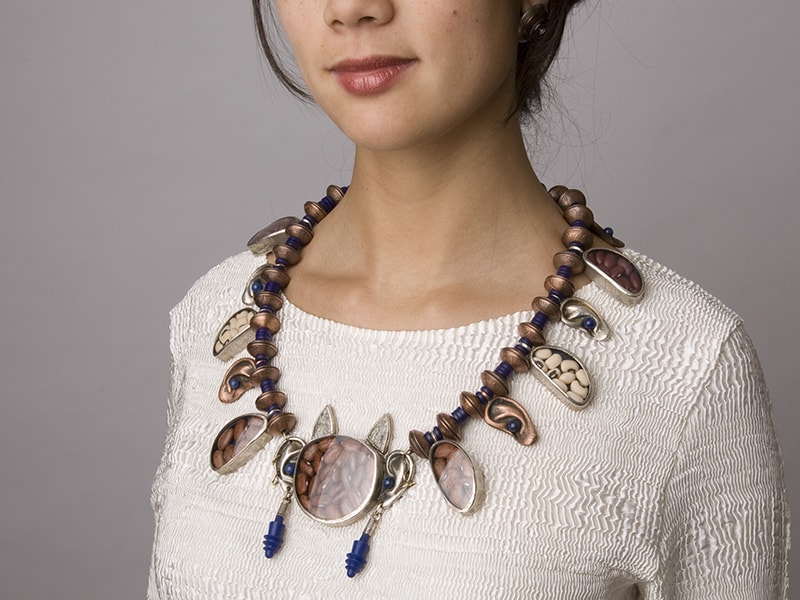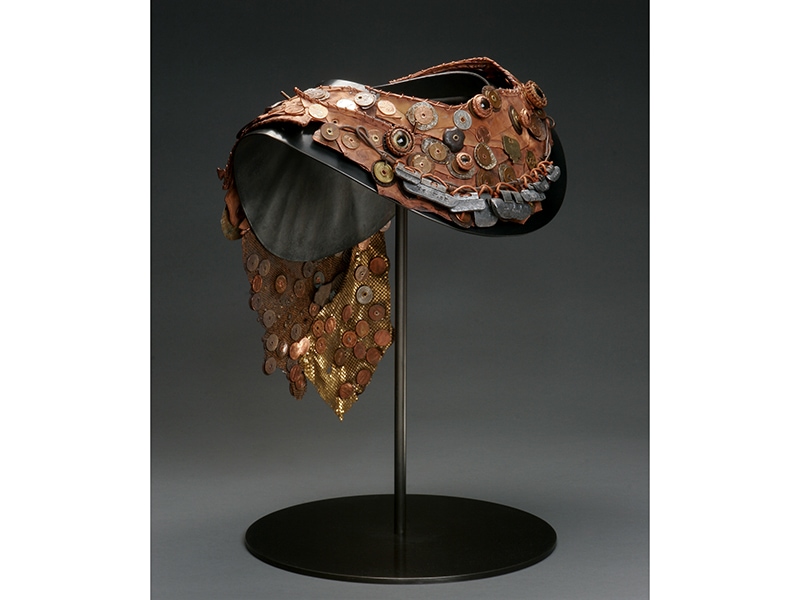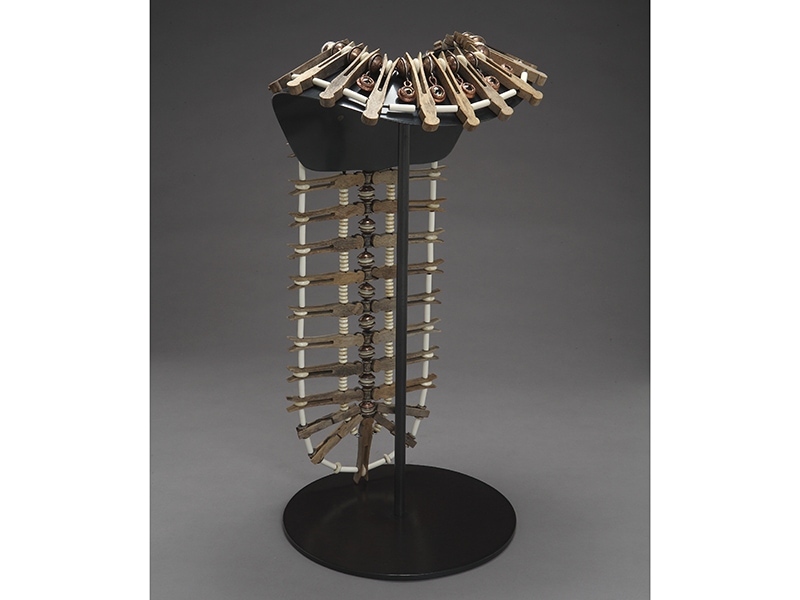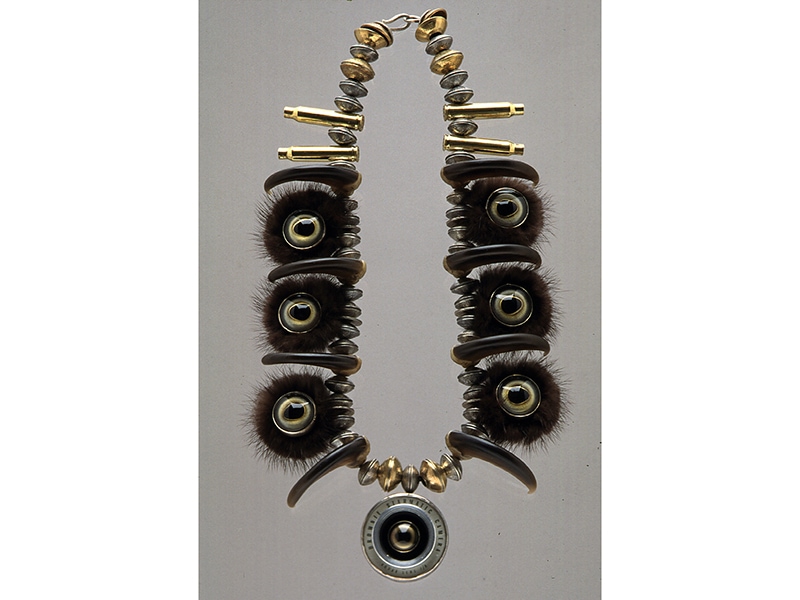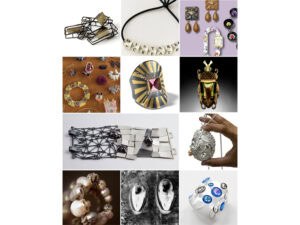Now that a red line has been drawn and crossed with the death of Seattle metals artist and sculptor Nancy Worden (1954–2021), it’s possible to take stock of a lifetime dedicated to transforming materials into ideas that in the process flowered into social and institutional critique and humor of the highest order. Setting aside for the moment her further contributions as juror, teacher, curator, exhibition designer, and tender of the sacred flame of her Ellensburg mentors, Ken Cory (1943–1994) and Les LePere, Worden’s art far outflanks her prodigious contributions to help other artists and, at the same time, help her own career and the fate of jewelry move ahead into assimilation, acceptance, and acclaim. Without the advantages of East Coast jewelry-making heritages and old-gal networks, let alone male or female role models, Worden grew up and matured, like her friend Merrily Tompkins (1948–2018), around male artists who generously allowed the two hippie chicks to hang out with them. Donald Tompkins (1933–1982), Merrily’s older brother, left Ellensburg and became a SoHo stalwart and major jewelry artist, while Worden and Merrily stayed behind or married and moved to Seattle. Plugging into a thriving, dawning contemporary art scene where no holds—or craft media—were barred, Worden quickly flourished on her own, especially after Cory’s premature death from undiagnosed diabetes.
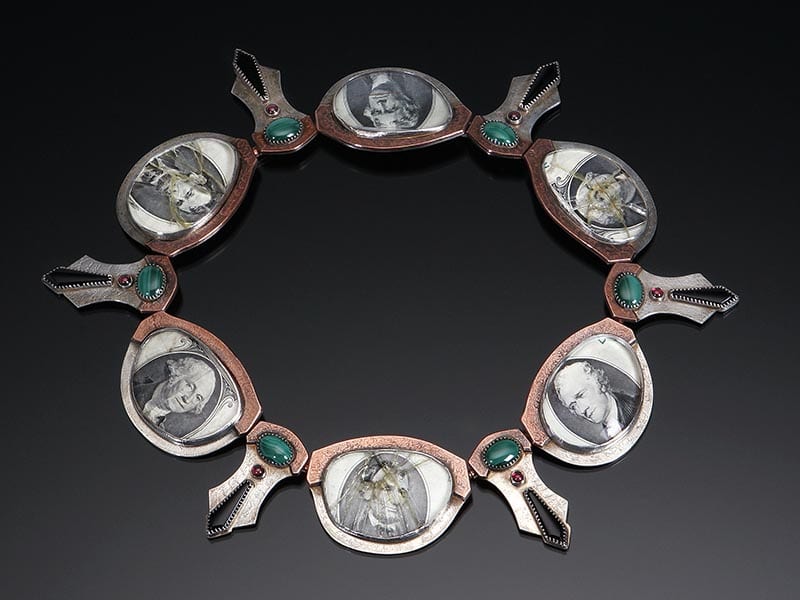
Worden’s own tragic death from genetically inherited ALS (which is also known as Lou Gehrig’s disease and took her mother as well) places a human context onto a lifetime spent constructing narratives about American social and cultural history. Its foibles, sins, and, ultimately, the comeuppances Worden assigned them are embodied in her ingeniously fashioned chains and chokers, with daringly high and low materials, and deeply subversive messages masquerading as high-fashion “wearable art”: necklaces, collars, cuffs, bracelets, breastplates, and equivalents of bullet- or bow-and-arrow-proof chest covers. Young enough to benefit from a window that opened for craft artists in the late 1970s and 1980s, after joining William Traver Gallery, in 1994, she thereafter exhibited primarily in art galleries and museums. It was Asian, European, and Scandinavian decorative arts curators in state art museums abroad who were drawn to her work, “discovered” at the famed Schmuckmuseum Pforzheim in 2007. The universality of her subjects—all beginning from personal or geographical sources—spoke to European curators and audiences. That precious West Coast commodity, humor in contemporary art, was something Worden brought to Europe in spades.

Not exactly the recipient of a plethora of bibliographic flurries and commentaries, Worden nevertheless attracted them, cultivating the attention of important art critics or cultural commentators depending where her work was shown: Australia, Belgium, and India, to name a few. With her place in the American craft elite secured during her lifetime, she frantically but patiently worked to fulfill what she knew was a finite stretch of being remaining for her, much like Bette Davis in the Warner Bros. film about a highly intelligent young woman diagnosed with a brain tumor, Dark Victory (1939), based on a play by George Brewer and Bertram Bloch. Worden’s legacy is a dark victory; a victory given how much she accomplished both for herself and others, but a dark one because of the cruel disease. She was unable to continue fulfilling her studio dreams. What a field day she would have had with today’s continuities of injustice, political imposture, and socially group-imposed deceptions!
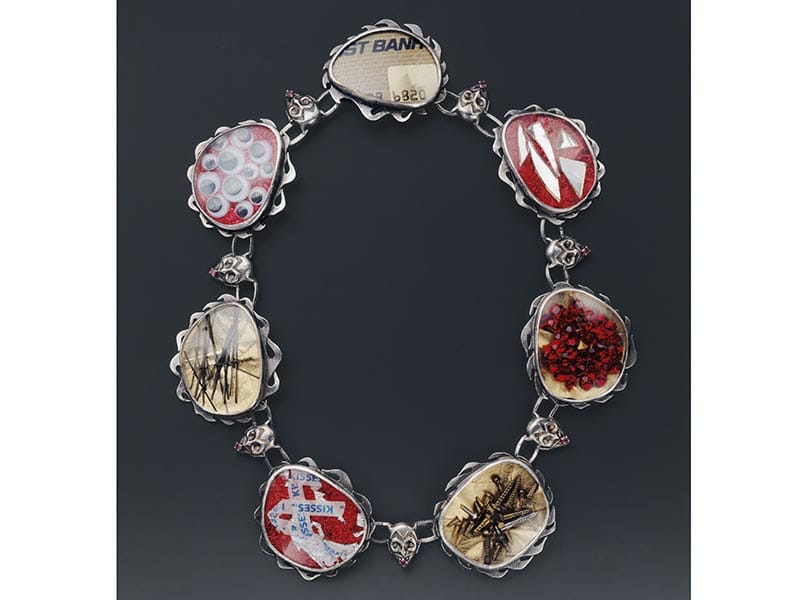
Does this leave her ultimately as a moralist, one closer to John Steinbeck and Émile Zola than Tom Robbins and Ken Kesey, her peer and regional literary counterparts? If we investigate her masterpieces, The Seven Deadly Sins (1994) and Frozen Dreams (2004), each work is dense with historical signage, highly compressed into didactic signs and symbols, conveyed by the flick of a wrist or tossed forearm. Prescription drug overdose, date rape, white settler attacks on wildlife and indigenous people—all are hinted at in various gorgeously gilt, silver, or gem-encrusted settings, eminently wearable, perennially at the forefront of “statement jewelry.”

In The Seven Deadly Sins, the explicit reinterpreting of sin also addresses Christianity, complicit in oppressive conditions for many women. This was important to Worden, daughter of a PhD feminist academic, once the family moved to Ellensburg, WA, US. This was where Worden benefited from Central Washington University’s fine arts department, an amazing birthing center for creative, often hilarious, mock-cowboy and cowgirl artisans and artists. From obscene belt-buckles to bulletproof-corset stays, the Ellensburg Funky group, which included Worden and Tompkins, produced brilliant artists who perpetuated a unique regional style of deadpan humor and exquisite craftsmanship. Inject 1960s political content and you have the womb that gestated the young Nancy Worden. (Her graduate work with Gary Noffke, at University of Georgia, Athens, intensified her vision and talent, giving it greater urgency and wit.)
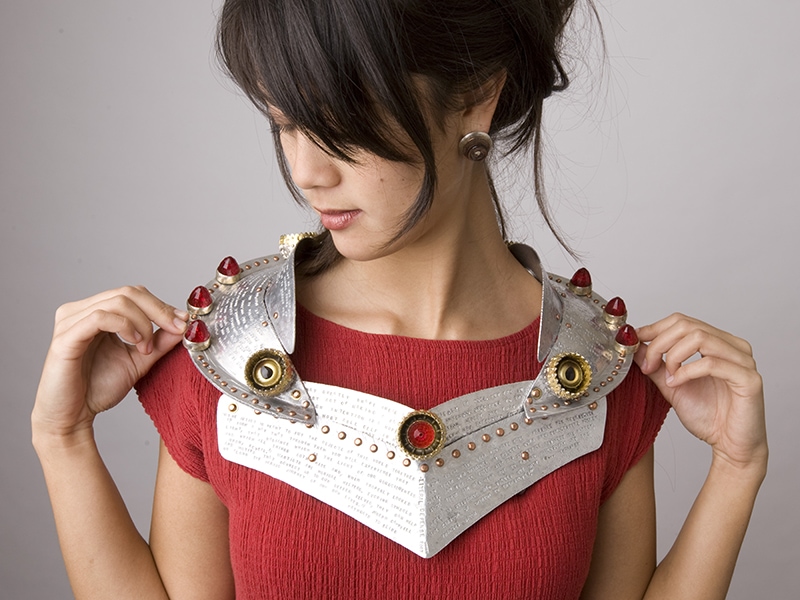
These links and others have been assiduously discussed in various art museum publications about her, including Loud Bones: The Jewelry of Nancy Worden, by the law professor Michelle LeBaron and the art historian Susan Noyes Platt (Tacoma Art Museum, 2009). Foreseeing her end, Worden planned and oversaw every aspect of the Tacoma retrospective, working with chief curator Rock Hushka. In so doing, she repeatedly upheld and raised the gold standard for scholarship, critical writing, and institutional recognition of craft art, spearheading the assembly of a visible-storage jewelry art collection at Tacoma Art Museum, another project in which she foresaw future appreciators, her oracular curatorial style meshing with the oracular or prophetic content of her brooches and necklaces.

By singling out various channels and substrates of women’s lives—reproductive freedom, military conscription of women, consumer targeting of women, the tyranny of beauty salons—Worden was able to poke fun but draw attention to issues that interested her. Was she like Shirley Jackson, author of the famed short story, “The Lottery,” who split her time between quiet horror stories and sappy but lucrative “family circle” tales she sold to women’s magazines? No, probably more like Joyce Carol Oates, who taught full-time at Princeton and managed to write 58 novels. It will take years for younger curators to categorize and piece together the overarching social intentions of Worden’s art: to let jewelry reclaim its power from the Middle Ages when one head on one coin could save or damn an empire, so important were metals as monetary currency and personal adornment. Her extravagant neckpieces allude to Babylonian queens who went into battle. They stand in for all ornament that shouts status and demands attention, but by fashioning them into metallic petals and paillettes, Worden validates women’s work without overriding their demand for personal ornament. Determined to carry social meaning, her necklaces are no longer potluck jewelry in the style of Ramona Solberg (1921–2005), an early mentor from Ellensburg, but ornament of oracular grandeur.
There is no cure for ALS. Worden put into motion all the mechanisms of her posterity long before her death; she knew that if she did not, she could not count on her generation of art museum curators to get the idea on their own. In this, she was right. Without pestering them, she continued to push for herself and others who she felt deserved a place at the table of art museum exhibition committee meetings. Without finding and controlling one curator after another, she could not count on their prior knowledge or interest in artists and artisans of the Pacific Northwest. First, she arranged Cory’s legacy and book; then, she returned to making more masterpieces for her own thick elegy, Loud Bones. Was there a prophetic tone or pun in the title? The progression of ALS involves gradual loss of neural control and can affect bones and joints. More likely, it is the exhilarating atmosphere of unconcealed or “loud” construction that makes each work float upon, rather than claim, its wearer. Communication, whatever parameters it might involve, was paramount to Worden; ornament was the vehicle. Communication was the conversation-starter enjoyed by the wearer and owner.
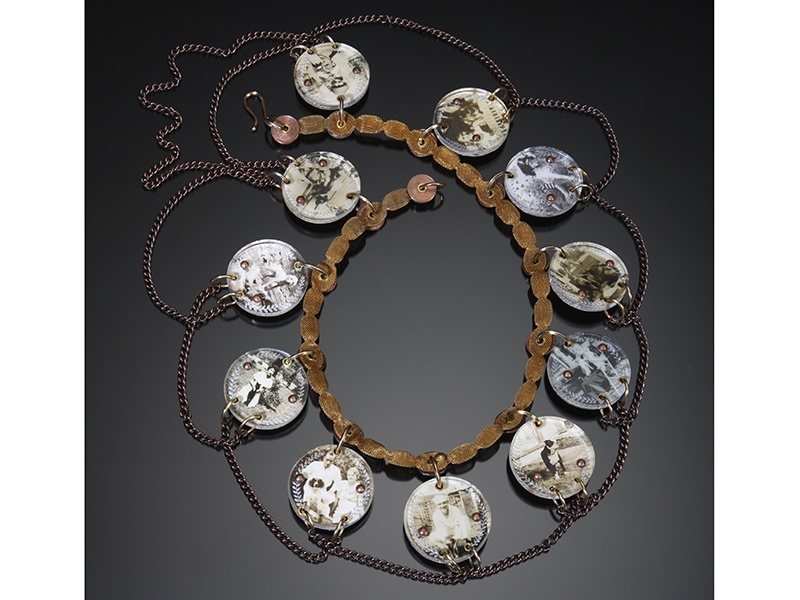
Who is to say someday these assemblages won’t be displayed at home in their own locked cases, like the vintage rifles and shotguns of Central Washington state she saw as a teenager? In the meantime, her prescient placement of her works in major American and European art museums will guarantee their accessibility to visitors, curators, and critics seeking her particular blend of personal expression, mordant comedy, and brilliant technical execution for some time to come.
